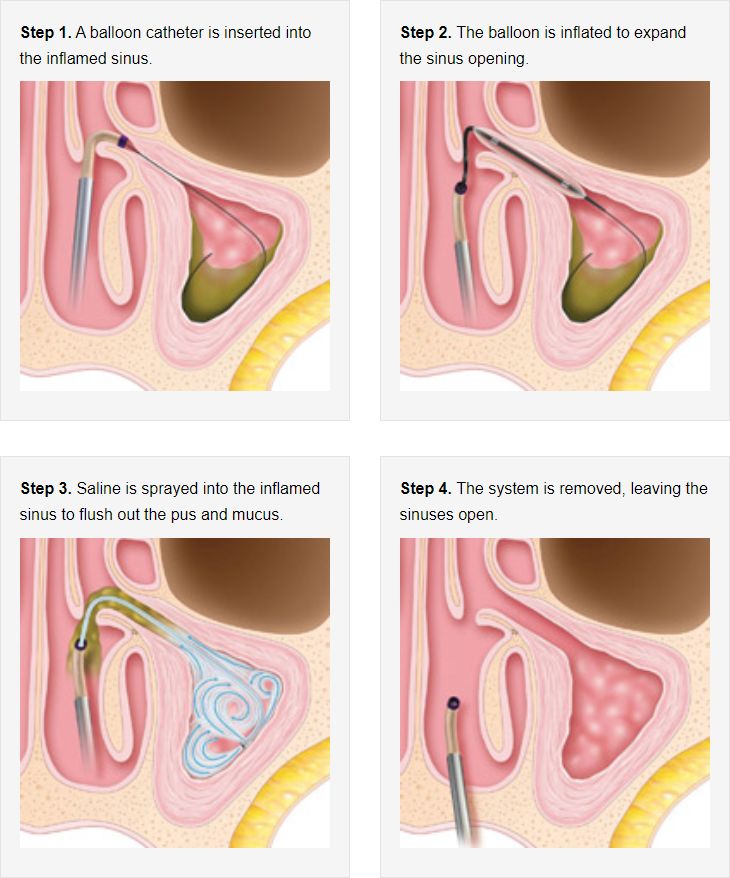Balloon Sinuplasty Procedure
Home | Sinus Conditions | Balloon Sinuplasty
How Does Balloon Sinuplasty Work, And What Is It Exactly?
Balloon sinuplasty, also known as balloon sinus dilatation, is a type of endoscopic, minimally invasive nasal surgery. This form of sinuplasty is a breakthrough procedure, and uses a flexible, small sinus balloon catheter to open the blocked sinus passageways. When the sinus balloon is inflated, it gently restructures and widens the walls of the passageway while maintaining the integrity of the sinus lining.
Why Do I Need Balloon Sinuplasty?
You may be a candidate for this procedure if you have chronic sinusitis which is not responding medical management like steroids or antibiotics; or if you have acute recurrent sinusitis at least three times a year, and if your CT scan shows mild disease with mostly bony obstruction rather than swelling.
What Is The Difference Between Endoscopic Sinus Surgery And This Procedure?
Endoscopic sinus surgery is generally done under general anaesthesia. It involves removing diseased bone and lining in the affected sinuses, opening up the blocked sinus passageways. In contrast, this procedure can be done under local anaesthesia in the clinic, or under general anesthesia. It does not remove any bone and tissue, but instead focuses on restructuring and widening the walls of the sinus passageways.

Is Balloon Sinuplasty The Correct Procedure For Me?
Whilst this procedure can be an exceptionally effective way to clear sinuses for many patients, it may not necessarily be the right choice for every patient. For example, its use is limited to certain sinuses and may not be appropriate for others. A comprehensive consultation with us will help you make the decision which to choose.
What Are The Benefits Of Balloon Sinuplasty?
Balloon Sinuplasty benefits are as follows:
A Minimally Invasive Procedure
This procedure uses soft, small and flexible devices inserted through your nostrils to gently open your sinus passageways. In most cases, there is no bone or tissue removal.
Reduced Bleeding
As no bone or tissue with this procedure, it results in reduced bleeding when compared to regular sinus surgery. It also does not require uncomfortable nasal packing.
Improved Recovery Time
In general, patients experience fast relief with this treatment; however, each patient’s recovery time will differ. Generally, you can expect to get back to your normal daily routine within 24 hours.
Convenient
The balloon sinuplasty procedure can be done comfortably and quickly in an inpatient or outpatient setting.
Does Not Limit Treatment Options
Balloon sinuplasty is an endoscopic tool and may be used with other medical therapies or sinus surgery techniques. It does not limit future treatment options if you have progressive disease.
What Are Some Balloon Sinuplasty Risks?
The risks of this procedure may include:
Tissue Damage
There is a small risk of nose lining/tissue damage from the expansion of the balloon.
Eye injury
Since the procedure is being performed near your eye, it could affect the nerve to the eye; although this is exceedingly rare.
Infection
Your sinuses are prone and sensitive to infection. However, antibiotics will be administered post-operatively to reduce the chances of an infection occurring.
Nasal congestion
Some patients may experience nasal congestion after balloon sinuplasty but this is generally transient and resolves as the patient recovers. Patients may also need to use a nasal douche to clear nasal secretions post-balloon sinuplasty.
Any surgery comes with risks, and this procedure is no different. However, it has been shown to be effective and safe in many studies so far. In fact, certain studies have reported the safety and effectiveness of this procedure, including sinus patency, radiographic evidence and improved sinus-related quality of life after the procedure for up to two years. This study examined the adverse events during an assessment of the procedure in 28,500 patients and identified only 3 major complications totaling 85,000 treated sinuses.
Is Balloon Sinuplasty Painful / Does Balloon Sinuplasty Hurt?
The procedure is generally well tolerated by patients. Local and topical anaesthesia will be administered prior to the procedure. There may be a sensation of pressure in the nose when the procedure is being performed.
What Is Balloon Sinuplasty Recovery Time Like, And What Is The Balloon Sinuplasty Success Rate?
After the procedure, most people can go home after a few hours and most of our patients can return to regular activities after 24-48 hours. However, may be advisable to avoid strenuous activities and heavy lifting for at least a week. Nose blowing is typically not encouraged for the first week after surgery. Pain may be experienced and is usually mild; and can be controlled with mild painkillers and anti-inflammatory medication.
The procedure is effective in patients with simple forms of chronic sinusitis. Patients who have chronic sinusitis with nasal polyps may be better candidates for endoscopic sinus surgery instead of this procedure. However, this varies from patient to patient as well. The efficacy, or success rate, of the procedure has been shown in studies to equal outcomes from endoscopic sinus during the initial 2 to 5 years after the procedure when performed in appropriately selected patients.

